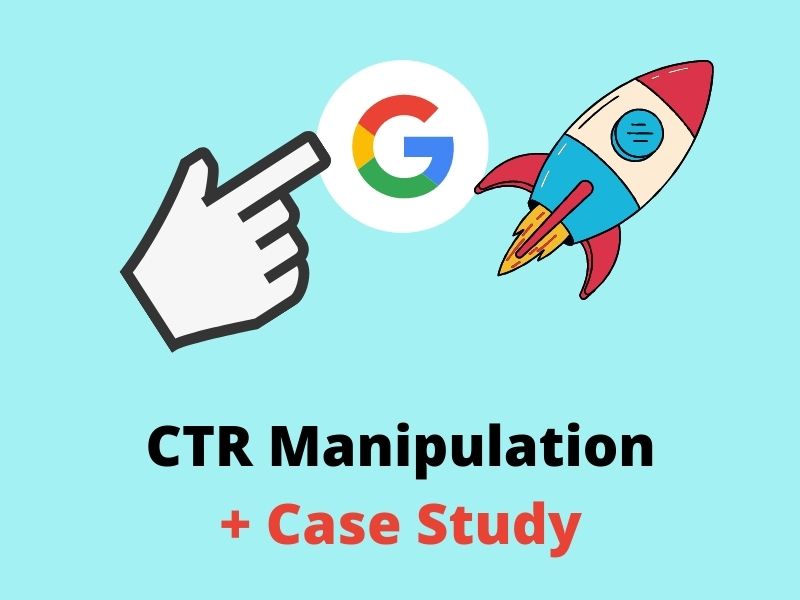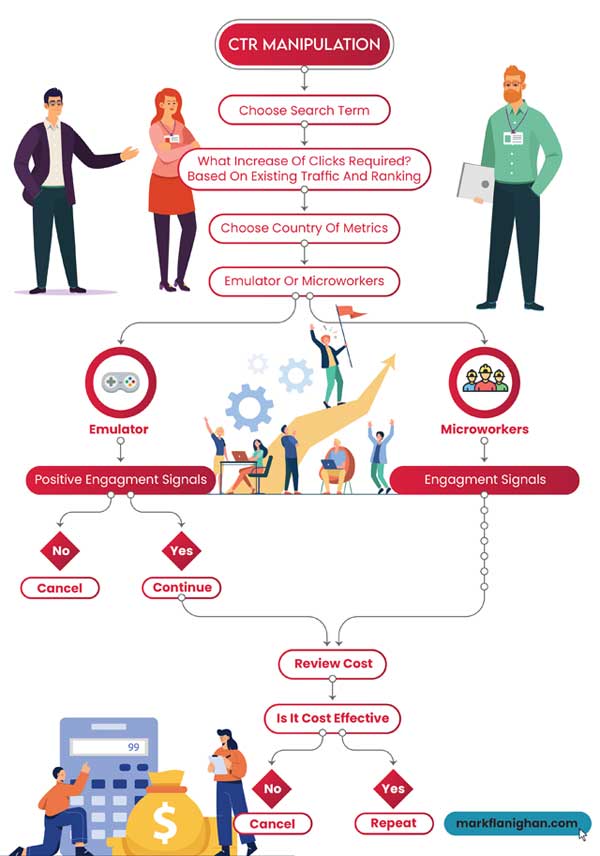The Ultimate Guide to Executing Effective CTR Manipulation Strategies
The Ultimate Guide to Executing Effective CTR Manipulation Strategies
Blog Article
Achieving Success With Targeted CTR Adjustment
The optimization of click-through rates (CTR) is a vital undertaking for brands aiming to enhance their electronic existence and make best use of involvement. Targeted CTR adjustment incorporates a variety of methods, from data-driven ad placements to the advancement of engaging web content tailored to details audiences. Recognizing the subtleties of user behavior and utilizing methods such as A/B testing can significantly affect performance outcomes. The journey to grasping these tactics is intricate and requires an ongoing commitment to evaluation and refinement. The question continues to be: what particular methods will yield one of the most substantial outcomes in this vibrant landscape?
Recognizing Click-Through Fees
Click-through prices (CTR) function as a crucial statistics in digital advertising and marketing, reflecting the efficiency of on-line content in driving customer involvement. This metric is computed by dividing the number of clicks an ad or link gets by the overall variety of impacts, shared as a percent (LinkDaddy CTR Manipulation). A higher CTR suggests that the material reverberates well with the target audience, triggering them to do something about it
Comprehending CTR is essential for marketers intending to maximize their campaigns. Numerous factors influence CTR, consisting of ad placement, layout, and the importance of the content to the target market's interests. Engaging headings and aesthetically attractive pictures can considerably improve the probability of users clicking on a link.
In addition, the context in which the web content is offered plays a crucial role in establishing CTR. Eventually, a complete understanding of CTR encourages marketing experts to fine-tune their techniques, guaranteeing that digital campaigns achieve their preferred outcomes successfully.
Importance of CTR Control
In the affordable landscape of electronic marketing, the control of click-through prices (CTR) has come to be an important method for enhancing project performance. CTR works as an essential performance indication, mirroring the efficiency of on-line ads and content in attracting individual engagement. A greater CTR not just signifies higher rate of interest yet additionally can lead to improved internet search engine positions and lower cost-per-click (CPC) prices, therefore maximizing overall marketing budget plans.
The relevance of CTR adjustment depends on its ability to inform marketers regarding consumer preferences and habits. By evaluating CTR data, businesses can recognize which components of their projects resonate most with their target market. This understanding enables even more educated decision-making and the appropriation of sources to the most efficient channels.
Additionally, effective CTR manipulation promotes an affordable advantage. Brand names that constantly achieve higher CTRs can outshine rivals, protecting an extra considerable market presence. In an era where customer interest is short lived, catching clicks translates directly to boosted leads and conversions, eventually driving organization growth. Therefore, understanding CTR control is not simply helpful; it is crucial for achieving continual success in digital marketing campaigns.
Techniques for Targeted CTR
Attaining targeted click-through prices (CTR) calls for a calculated strategy that includes numerous methods tailored to specific audience sectors. One efficient method is enhancing advertisement positionings by making use of information analytics to recognize high-performing channels. By concentrating initiatives on these channels, marketing experts can improve presence and rise involvement.
Another critical method is crafting engaging headlines and phones call to activity (CTAs) A/B testing different variants can expose which mixes resonate most with the target audience, thus driving greater CTR. In addition, including aesthetic elements such as eye-catching images or video clips can considerably boost appeal, making content extra interesting and shareable.
Customization additionally plays a vital function; using customer information to produce tailored content can promote a feeling of relevance, motivating clicks. Furthermore, leveraging social evidence through endorsements and user-generated content can construct depend on, ultimately enhancing CTR.
Analyzing Individual Behavior
 Comprehending user actions is essential for maximizing advertising approaches and improving overall CTR Manipulation efficiency. By examining how individuals communicate with web content, online marketers can obtain valuable insights into choices, inspirations, and discomfort points. This expertise makes it possible for the growth of more targeted projects that reverberate with details target market sections.
Comprehending user actions is essential for maximizing advertising approaches and improving overall CTR Manipulation efficiency. By examining how individuals communicate with web content, online marketers can obtain valuable insights into choices, inspirations, and discomfort points. This expertise makes it possible for the growth of more targeted projects that reverberate with details target market sections.To successfully evaluate individual habits, numerous devices and approaches can be employed. Internet analytics platforms offer information on user engagement metrics such as click-through prices, bounce prices, and time invested in web page. Heatmaps and session recordings permit marketing experts to imagine individual interactions, disclosing which elements stand out and which may be neglected.
Additionally, customer feedback with surveys and feedback forms can provide qualitative understandings, improving the understanding of user belief and satisfaction. Segmenting individuals based on behaviors, interests, and demographics can even more refine targeting efforts, customizing content to satisfy diverse requirements.
Eventually, constant evaluation of individual actions is essential for adjusting advertising strategies in real-time. As individual trends develop, remaining attuned to these adjustments makes sure that projects continue to be efficient and appropriate, fostering a much deeper link with the target market. This fundamental understanding sets the stage for the successful application of targeted CTR control strategies.
Measuring Success and Adjusting Methods
Gauging success in targeted marketing campaigns calls for a tactical technique that integrates performance metrics with ongoing evaluation. Trick performance indicators (KPIs) such as click-through rates (CTR), conversion rates, and customer purchase expenses need to be monitored constantly to determine the performance of adjustment strategies. By developing a baseline, marketers can assess adjustments in CTR and determine trends that show effective interaction or prospective imperfections.
Routinely analyzing these metrics permits for the prompt adjustment of techniques. For instance, if a certain project shows a substantial decrease in CTR, it may signal the requirement for creative revisions or a reevaluation of targeting specifications. Employing A/B screening can even more improve methods by contrasting variations of ads or landing web pages, offering insight into what resonates best with the target audience.
Furthermore, integrating qualitative comments via studies or customer meetings can supplement quantitative data, providing an extensive sight of target market perception. Eventually, the capability to iteratively examine and fine-tune approaches based on real-time information promotes a more receptive advertising and marketing strategy, ensuring that campaigns remain aligned with business purposes and audience choices. This flexible method is crucial in attaining sustained success in targeted CTR control.
Final Thought
In final thought, targeted CTR control is necessary for maximizing electronic advertising and marketing initiatives - CTR Manipulation. Inevitably, successful CTR manipulation not just boosts presence yet additionally fosters trust and integrity, consequently contributing to sustained development in competitive markets.
 Targeted CTR manipulation includes an array of approaches, from data-driven advertisement positionings to the growth of engaging web content tailored to details audiences.Click-through prices (CTR) offer as an important metric in electronic advertising and marketing, mirroring the efficiency of online material in driving user involvement. A greater CTR indicates that the web content reverberates well with the target audience, prompting them to take action.
Targeted CTR manipulation includes an array of approaches, from data-driven advertisement positionings to the growth of engaging web content tailored to details audiences.Click-through prices (CTR) offer as an important metric in electronic advertising and marketing, mirroring the efficiency of online material in driving user involvement. A greater CTR indicates that the web content reverberates well with the target audience, prompting them to take action.CTR offers as an essential efficiency indicator, showing the efficiency of online ads and material in attracting customer interaction.In conclusion, targeted CTR adjustment is crucial for enhancing electronic advertising initiatives.
Report this page